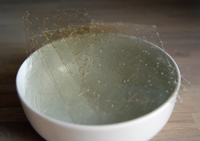
Photo from wikipedia
Stretchable, healable, biocompatible, and conductive hydrogels are one of the promising candidates for both wearable electronics and environmental remediation applications. To date, the design of hydrogels that integrate ultrafast self-healing… Click to show full abstract
Stretchable, healable, biocompatible, and conductive hydrogels are one of the promising candidates for both wearable electronics and environmental remediation applications. To date, the design of hydrogels that integrate ultrafast self-healing with high efficiency (seconds), high stretchability, and biocompatibility and reversibility into one system is not an easy task. Herein, we demonstrate a general oxidation approach to accelerate the hydrogelation of hPEI-based double network gels via the generation of fluorescent polymer clusters at room temperature or triggered by the heating-cooling process. The resulting ohPEI hydrogel has the merit of biocompatibility over most reported hPEI hydrogels for strain sensors. It shows a high conductivity (1.3 S/m), an ultrafast self-healing ability (<3 s, 98% healing efficiency within 60 s), a high stretchability (∼1850 and ∼7000% in deformation), and reversible adhesivity on various material surfaces. The excellent performance of the hydrogel is ascribed to the cooperative and hierarchical interactions of four types of dynamic combinations, including the reversible borate bond, hydrogen bonding, electrostatic interaction, and polymer cluster interactions. The reversible fabrication process by the one-spot method (just by simple mixing of the components) and superior properties of the hydrogel make it an ideal candidate for a wearable strain sensor to monitor human motions and physiological activities. Moreover, it is also a good hydrogel absorbent for phase separation absorption of volatile organic compounds with a high capacity (for acetone: 4.75 g g-1), reusability, and an easy handling process.
Journal Title: ACS applied materials & interfaces
Year Published: 2022
Link to full text (if available)
Share on Social Media: Sign Up to like & get
recommendations!